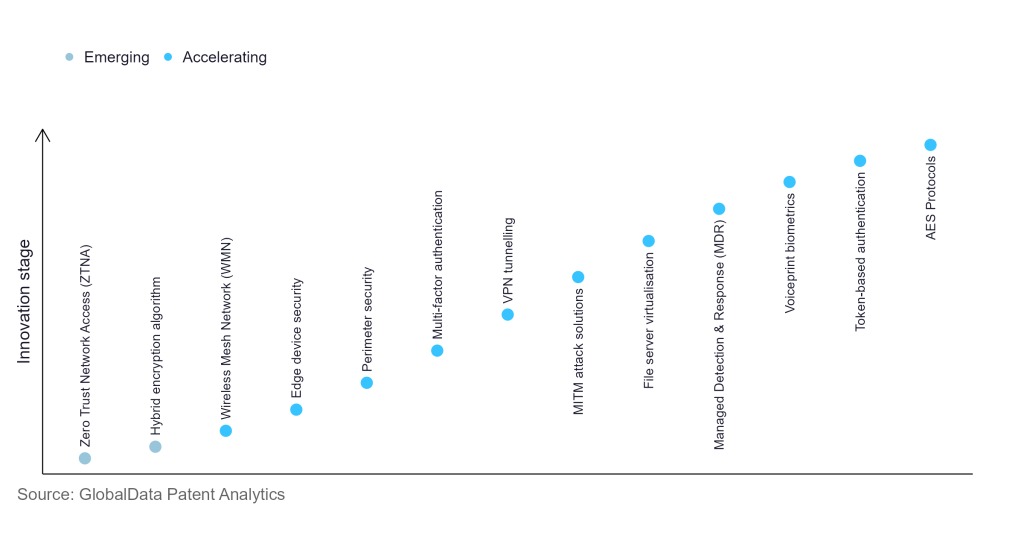The oil and gas industry continues to be a hotbed of innovation, with activity driven by the need for greater productivity and digitalisation whilst also securing data over networks and preventing a hacker attack, with the growing importance of technologies such as quantum computing, cybersecurity, and digital twins. In the last three years alone, there have been over 534,000 patents filed and granted in the oil & gas industry, according to GlobalData’s report on Cybersecurity in Oil & Gas: VPN tunnelling.
However, not all innovations are equal and nor do they follow a constant upward trend. Instead, their evolution takes the form of an S-shaped curve that reflects their typical lifecycle from early emergence to accelerating adoption, before finally stabilising and reaching maturity.
Identifying where a particular innovation is on this journey, especially those that are in the emerging and accelerating stages, is essential for understanding their current level of adoption and the likely future trajectory and impact they will have.
40+ innovations will shape the oil & gas industry
According to GlobalData’s Technology Foresights, which plots the S-curve for the oil & gas industry using innovation intensity models built on over 256,000 patents, there are 40+ innovation areas that will shape the future of the industry.
Within the emerging innovation stage, zero trust network access (ZTNA) and hybrid encryption algorithm are disruptive technologies that are in the early stages of application and should be tracked closely. Wireless mesh network (WMN), edge device security, and perimeter security are some of the accelerating innovation areas, where adoption has been steadily increasing.
Innovation S-curve for cybersecurity in the oil & gas industry
According to GlobalData’s Technology Foresights, which plots the S-curve for the oil & gas industry using innovation intensity models built on over 256,000 patents, there are 40+ innovation areas that will shape the future of the industry.
Within the emerging innovation stage, zero trust network access (ZTNA) and hybrid encryption algorithm are disruptive technologies that are in the early stages of application and should be tracked closely. Wireless mesh network (WMN), edge device security, and perimeter security are some of the accelerating innovation areas, where adoption has been steadily increasing.

VPN tunnelling is a key innovation area in cybersecurity
A VPN tunnel helps to provide a secure, encrypted connection between a device and VPN server. As a result, Internet service providers cannot access a user’s data and hackers can't crack the connection without a cryptographic key.
GlobalData’s analysis also uncovers the companies at the forefront of each innovation area and assesses the potential reach and impact of their patenting activity across different applications and geographies. According to GlobalData, there are 10+ companies, spanning technology vendors, established oil & gas companies, and up-and-coming start-ups engaged in the development and application of VPN tunnelling.
Key players in VPN tunnelling – a disruptive innovation in the oil & gas industry
‘Application diversity’ measures the number of different applications identified for each relevant patent and broadly splits companies into either ‘niche’ or ‘diversified’ innovators.
‘Geographic reach’ refers to the number of different countries each relevant patent is registered in and reflects the breadth of geographic application intended, ranging from ‘global’ to ‘local’.
Leaders in patent filings for VPN tunnelling for the oil and gas industry include Solvay, Siemens, and Schlumberger. Maximising cybersecurity and reducing cyberattacks is a primary objective of all these companies, which are therefore at the forefront in developing technology for VPN tunnelling.
VPN tunnelling for the oil and gas industry needs to be carried out in a wide variety of settings from desert to offshore installations, or even under the seabed. Consequently, VPN tunnelling needs to be configured accordingly to suit a wide variety of requirements and conditions. Evolving technologies can help companies to work without any problems across these challenging conditions.
To further understand how cybersecurity is disrupting the oil & gas industry, access GlobalData’s latest thematic research report on Cybersecurity in Oil and Gas (2022).
GlobalData, the leading provider of industry intelligence, provided the underlying data, research, and analysis used to produce this article.
GlobalData’s Patent Analytics tracks patent filings and grants from official offices around the world. Textual analysis and official patent classifications are used to group patents into key thematic areas and link them to specific companies across the world’s largest industries.